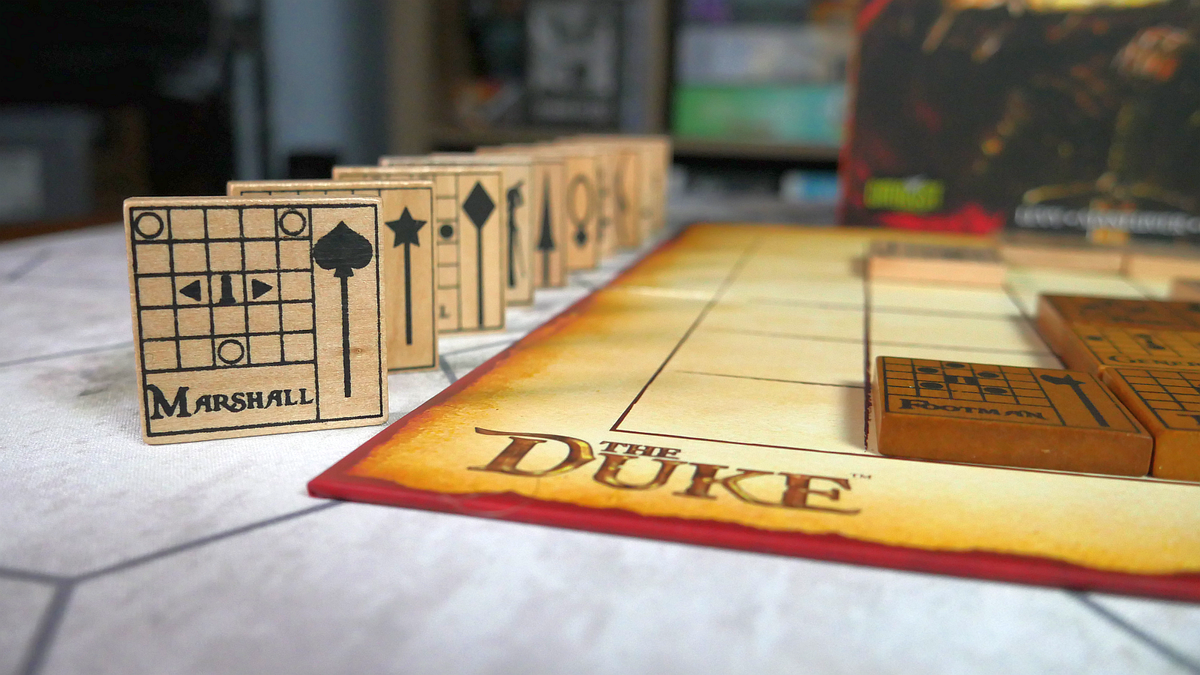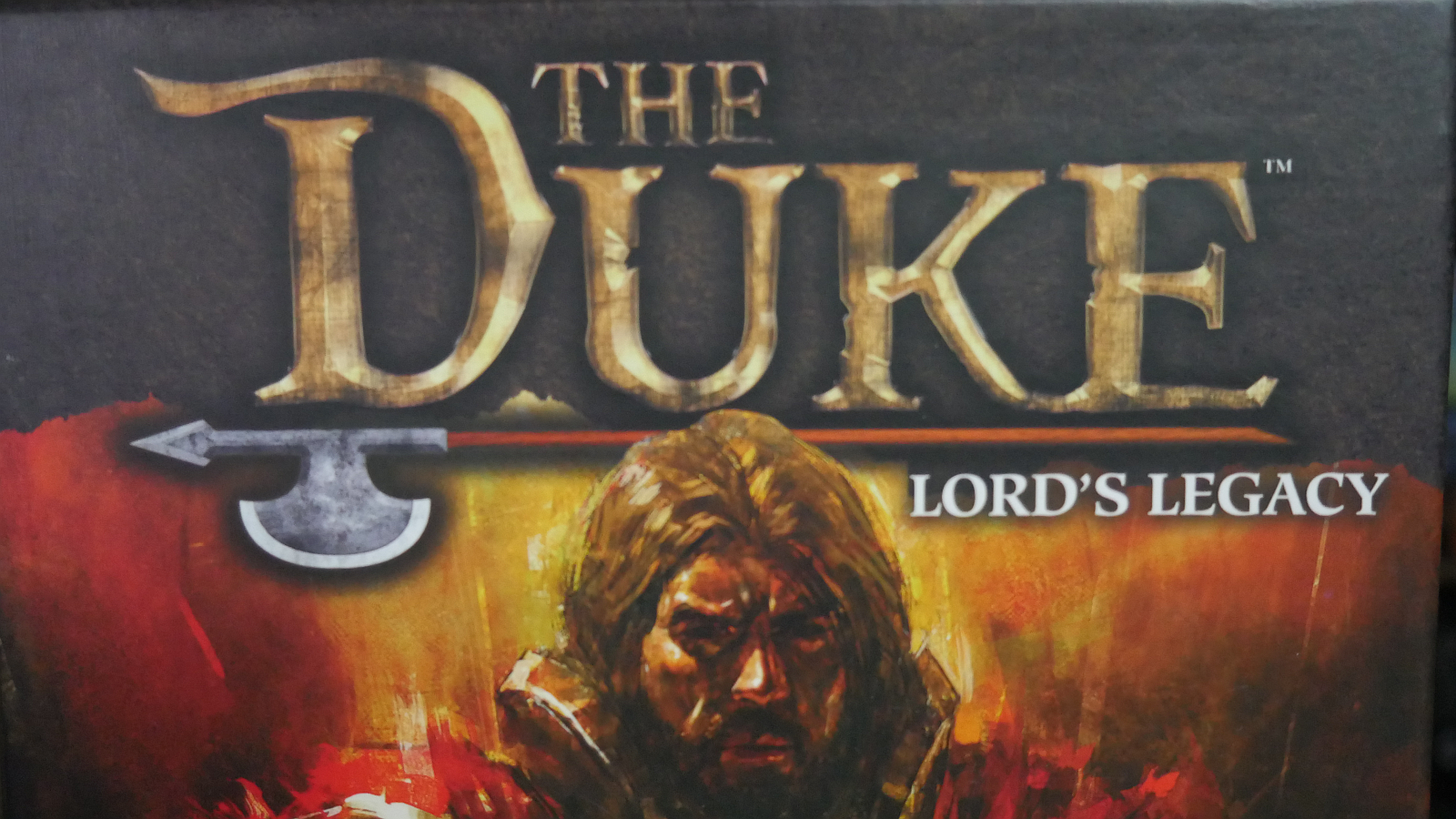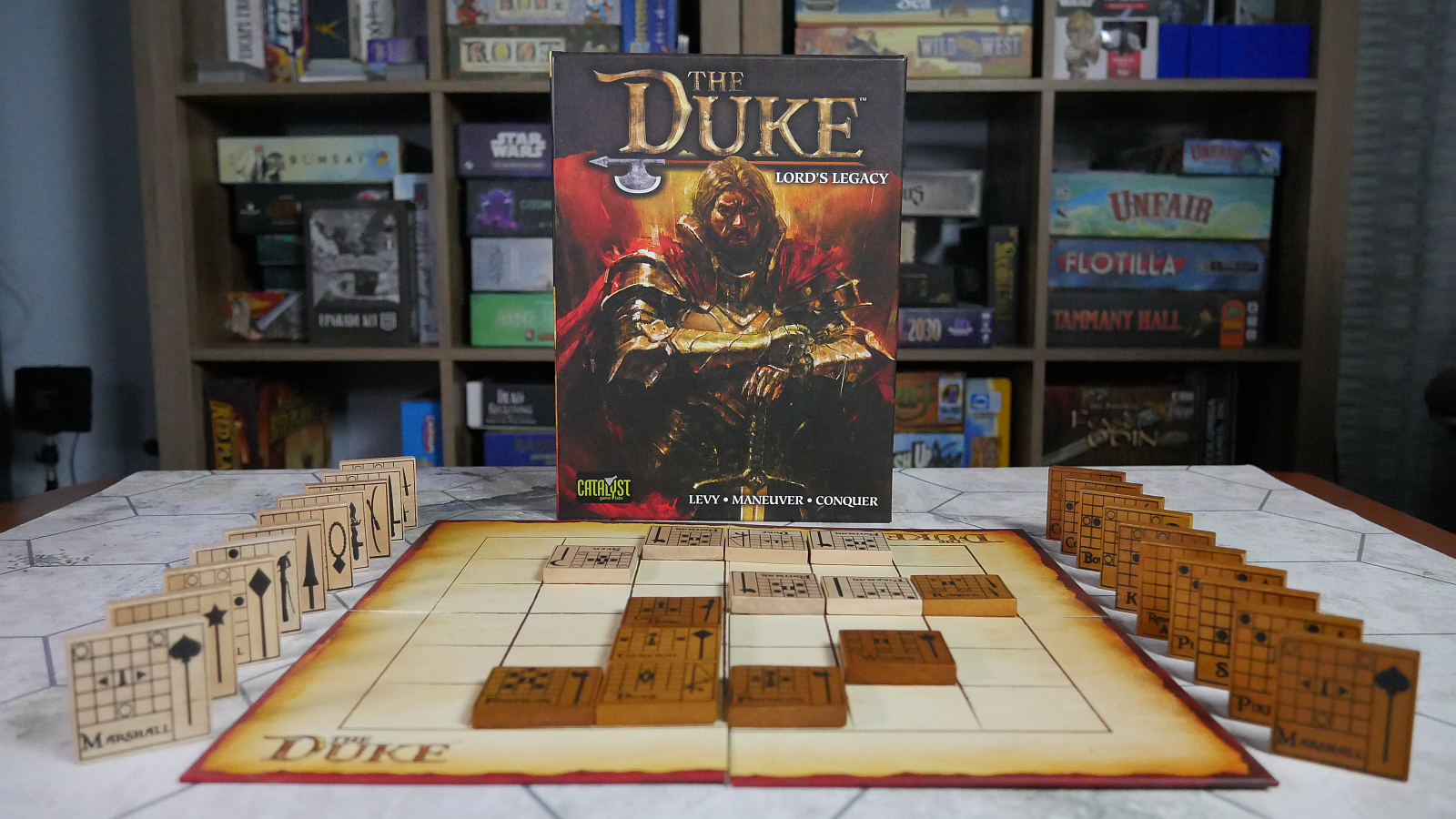
A lesson in defeat
As a child, my father taught me to play Chess when I was about 7 years old. We would play off and on for the remaining 10 or so years that I lived at home and for that entire time, he beat me mercilessly. I never studied Chess or practiced beyond our occasional games, so it’s no surprise that I never got the upperhand on my vastly more experienced father. Despite the decade of losses it still ignited in me a love for strategy and competition. It also taught me how to deal with losing gracefully which continues, to my chagrin, to feature heavily in my board game journey to this day. Sigh…. Boy, do I wish we’d had The Duke rather than Chess. I could have given that old man some of his own medicine.
The Duke: Lord’s Legacy is a reprint of the original 2013 The Duke which changes none of the base rules, but includes new tiles, the Arthurian Legends expansions, a rewritten rulebook, and upgraded packaging.

Chess by any other name
The Duke is a chesslite game. A term I definitely just coined. In the same way that video game roguelikes and roguelites are constantly being released and the formula improved, there is a never ending flow of chesslike and chesslite games onto our tabletops.
If chess wasn’t such a great game, it wouldn’t have lasted for the past 1,500 years. Yet, with that much history, chess can feel like a bit….much. People spend their lives studying the game. They memorize the strategies and common board states. As a person who loves games but also has a job and a family, that’s just too much. In comes the chesslites. A way to capture the same feel of chess, that two player head to head battle one agonizing move at a time, but in a way that is faster, more accessible (sort of, more on that later), and more forgiving of your lack of years worth of practice and study.
Checkmate
In The Duke, players start the game with only three pieces on the board. Their Duke and two Footmen. On your turn, you can do one of two actions. Activate a tile on the board, or draw a new tile from your reserve bag. Tiles are activated according to their individual movement and attack abilities. New tiles must be placed orthogonal to your Duke. Players take turns, one action at a time, until one player captures the other’s Duke.
Every unit has a unique set of possible movement directions, movement styles, and potential attacks. Units can jump, slide, teleport, order other units, and attack at range all depending on the unique combo and layout of symbols on their tile. Like Chess, ending movement on top of an enemy captures that piece. Ranged attacks capture without having to move. With the exception of the “Order” action, all of the symbols are clear and easy to remember after just a few turns. The “Order” action is denoted by two tiny triangles in the corners of squares and is easily missed if you are not paying close attention.
Learning how all of the units can move is a pretty big commitment. There are way more possible outcomes in The Duke than a standard Chess set. Having to study each piece for how it can move as well as enemy pieces for how they can move can be pretty time consuming and slow the game down quite a bit as you learn it. Throw in the final rule that you flip the tile over and it gets completely different movement options every time you activate it, and there is a lot to take in and learn. I imagine if you play this game enough, it will start to speed up, but with 17 different units to learn it’s going to take a lot of play. For reference, our first game took about two hours. My opponent and I were both really focused on making smart plays though so every game isn’t going to be that long. I have since had games as short as ten minutes and everywhere in between.

So it’s Chess with more rules?
Starting the game with only 3 pieces on the board drastically reduces the number of decisions that the player has to think about compared to chess. From there, deciding to work with what you have already or to draw a new tile is where all of the strategy comes in. The urge to draw a new tile and see what new options are available to you is so strong, but if you do that, you’re not affecting your opponent at all. The mystery and potential of what could be on that next tile is surprisingly addicting. You know you don’t need another piece… but what if you get your Knight? Better draw one more. Meanwhile your opponent has completely out maneuvered you.
Having the reinforcements as a random bag draw rather than open selection was a smart choice. Both players get invested every time a tile is drawn. Leaning over the board to see what the new unit is. Sometimes you get a perfect draw with a new unit that can immediately threaten the opponent and change your footing. Other times you draw an assassin into a spot where it can’t move and becomes useless for the rest of the game. The highs and lows of the random drawing add just enough excitement to elevate the otherwise dry strategy of moving chess pieces around a board. Hate luck? I guess you can keep playing Chess.
Expanded Play
If learning all 34 movement patterns (17×2) was too easy for you, then there are a few additional options to increase the complexity. We didn’t play any of these, as the core game is satisfying and complex enough, but I will briefly cover them here if you are interested in expanding your game.
The first is Enhanced Abilities. This adds four special abilities to specific tiles denoted by roman numerals in the bottom right corner. While all of the normal movement options are referenced on the included reference card, these special abilities are not. You will need to consult the rulebook until you memorize them.
The Arthurian Legends expansion adds a handful of new tiles representing Arthur, Merlin, Camelot, Guinevere, Lancelot, Perceval, Morgana, and Mordred. For the most part, the game is the same, but each player’s Duke is replaced by Arthur and Morgana with the other named pieces replacing their thematic counterparts from the base game as well. These tiles all function by the normal rules but with new and powerful movement layouts. Camelot, or the Fort on the backside, has a new mechanic depending on if you choose to use it as a Fort or as Camelot for the game. The Fort functionally protects an occupying piece from anything but a lateral move. Camelot works the same as the Fort but additionally allows Morgana to convert the opposing players pieces to her side if she occupies it.
The bits
The tiles in The Duke are all stained wood with screen printed details. They are wonderfully tactile, and clacking them down on the board gives you the feeling of playing with something solid and purposefully designed rather than just a toy. If you struggle with your vision, you may have trouble distinguishing some of the movement icons. They are all represented in the rulebook, but even smaller than they are on the tiles. The board and tile bags are functional. I’d like to see a nice cloth bag for the tiles, but this isn’t a deluxe game, so it’s on par with a typical board game production. The box itself is appropriately sized and doesn’t waste space on your shelf.

Why yes, it is quite good
I have no qualms about recommending The Duke to anyone that enjoys the occasional Chess game but doesn’t want to study one game for the rest of their life. The unique units provide enough complexity and strategy to satisfy deep thinkers, and the randomness lightens it up enough for more casual gamers to still have a fun time. If luck in head-to-head strategy games isn’t your cup of tea, then probably steer clear. Played for fun, the Duke moves along smartly and provides a nice dose of strategy and competition. Played competitively or with someone who suffers from analysis paralysis and the game can really drag on, so choose your opponents wisely.
The Duke
Good
The Duke feels like a game that has been around for hundreds of years despite its 2013 origin. It has that instant classic feeling you get from a well designed abstract game. The randomness of the tile drawing places it below Chess for pure strategy, and all of the different movement options make it much higher than GamingTrend favorites Boop and Shobu for complexity.
Pros
- Chesslike
- Wooden bits
- Mix of strategy and luck
Cons
- Analysis paralysis danger
- Readability of tiles
